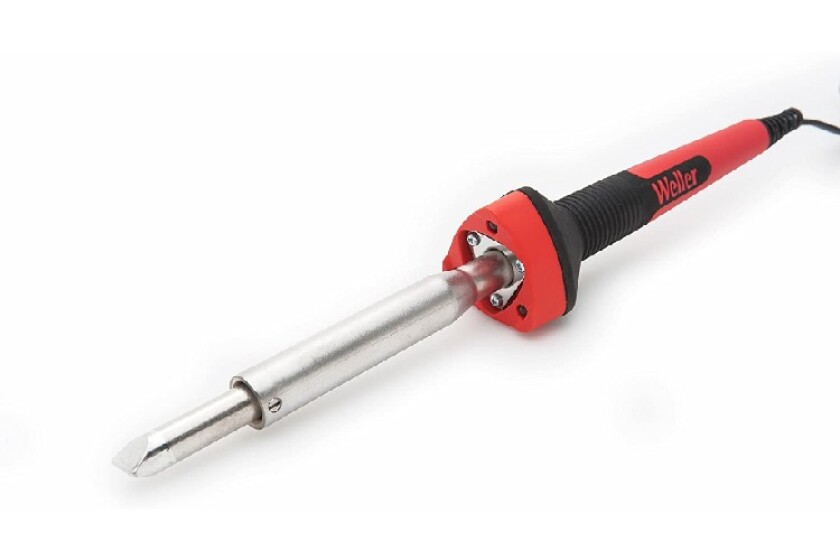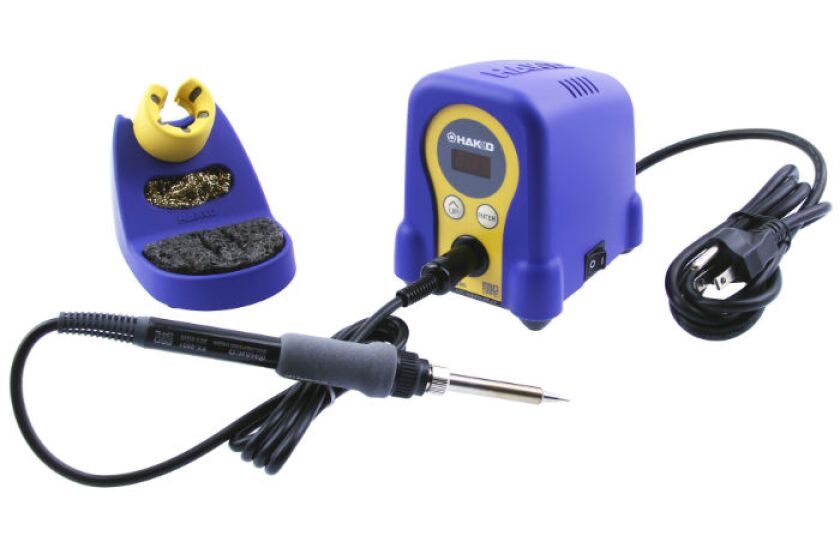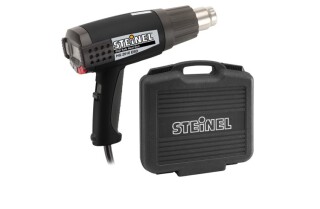The Best Soldering Irons for Small and Large Projects
-
Weller 80-Watts LED Soldering Iron -
Hakko Digital Soldering Iron -
X-Tronic Digital Display Soldering Iron -
Weller Soldering Iron -
Power Probe (PP PPSK) Self-Igniting Butane Soldering Iron -
Buyer's Guide
The process of soldering differs from welding in that it connects two pieces of metal together by melting a third piece of metal, one with a lower melting point. Welding, on the other hand, actually requires melting the metal that is being connected together. While additional metal might be added to the weld joint, it is of the same type that is being connected together.
Soldering can actually be used for a variety of purposes, such as "sweating" copper plumbing pipe together and making jewelry. However, when we’re talking about using a soldering iron, we aren't talking about those types of soldering. To solder plumbing pipe or jewelry, a torch is used. Although large soldering irons were used in the past by a tinsmith, in our modern era, the only thing a soldering iron is used for is making electrical connections.
The main reason why a soldering iron is used for electrical soldering rather than a torch is to localize the heat, controlling it so that it can't damage the components. While you could probably solder wires together with a torch, if you were to try and solder a printed circuit card with one, you would destroy it.
As electronic technology has improved over the years, there has been a need to improve the quality of soldering irons used for working on its components. The copper traces on modern circuit boards are much smaller than those found on electrical equipment manufactured 30 years ago. This means that the soldering irons must have better temperature control, as well as a smaller tip. A large tip or too hot a soldering iron could burn the board, detaching the copper traces.
Professional soldering irons used in industry are fairly expensive devices, often costing several hundred dollars. The main advantage of these tool is that they provide very accurate and adjustable temperature control. This allows the user to set the ideal temperature for the work they’re doing and be assured it will maintain that temperature within a very small tolerance.
For consumers, these soldering irons are a bit too much. I have one, which I've had for over 25 years, and it works remarkably well. But most of the soldering I do doesn't require that good a soldering iron, even when I'm repairing electronic equipment.
On the other end of the spectrum, there are inexpensive pencil type soldering irons with no temperature control whatsoever. The only control there is comes from the rating of the heating element. A higher wattage heating element will put out more heat than a lower wattage one. These inexpensive soldering irons aren't good enough for working on printed circuit boards but if all you are going to do is to solder wires together, they’re adequate for the task.
When selecting a soldering iron, you must select one appropriate to the purpose for which you’re going to use it. Always buy one adequate for your most critical task because that way it will work for less critical tasks as well. In this list, we are going to concentrate on soldering irons suitable for work on printed circuit boards, as selecting one for this application is harder than selecting an inexpensive one for simply soldering wires together.
There are three basic power sources for soldering irons; plugging them into the wall, batteries, or butane. While plugging in a soldering iron is less convenient, these soldering irons are the best for working on sensitive electronics, as they are the ones which provide ideal temperature control. Battery operated soldering irons don't work well as they go through batteries quickly and as the battery is used, the iron temperature drops. Butane models are good for emergency repairs in places where there is no electrical power, but one must be careful about damaging electronics with them. We've compiled the best soldering irons in 2022.
Get your soldering projects done right the first time
Weller 80-Watts LED Soldering Iron - Best Soldering Iron Overall
Weller is probably the biggest manufacturer of soldering guns, with the most models available. The temperature controlled iron I mentioned above is a Weller unit. Their equipment is top quality and while designed with industrial use in mind, their consumer line of equipment shows the quality their industrial line is known for.
This ESD safe soldering iron is part of their industrial line, but a lot of them are sold as consumer products. The controller and stand are separate to make it easier to locate on your workbench and you can use this iron all day long, as it’s designed for constant use. Temperature can be set anywhere from 350 degrees to 850 degrees Fahrenheit and held to plus or minus ten degrees. The innovative heater and sensor combination allow for quick heat-up and rapid temperature recovery while the station automatically powers down after 90 minutes of inactivity for safety and to help extend the life of the tip. Tips are replaceable, as well as the entire pencil, which is connected to the controller via a plug for easy changeovers.
Hakko Digital Soldering Iron - Runner Up
Hakko is one of Weller's biggest competitors. This soldering station is intended to be a high quality consumer product, providing an adjustable temperature range of 120 to 899 degrees Fahrenheit, with an accuracy at idle of 1.8 degrees. The digital display will read out in either Celsius or Fahrenheit, as you select with five preset temperatures which can be stored in the unit to facilitate ease of changing projects.
A ceramic heating element provides fast heat-up and thermal recovery as well as a wide selection of tips available for this unit and the stand has dual tip cleaners installed. This unit is ESD safe and will also work with Hakkko's FX-8804 hot tweezers for soldering of surface mount devices (SMD).

X-Tronic Digital Display Soldering Iron - Honorable Mention
X-Tronic is another strong competitor for Weller, producing a number of different soldering iron models, including this one, which is right on the edge between being an industrial or consumer unit. It has a temperature range of 392 to 896 degrees Fahrenheit, with 3.6 degree stability at idle. The digital display will provide temperature readout in either Celsius or Fahrenheit.
This kit comes with a lot of extras, giving tremendous value for the money and include a lighted magnifier for working, ten assorted soldering tips for a variety of applications and anti-static non-magnetic tweezers. It appears that X-Tronic is trying to make up for their lack of fame by providing a more complete soldering kit than the competition.
Weller Soldering Iron - Consider
For those that want a good soldering station for electronic repair, without paying the price of the units we've seen, I'd recommend Weller's WLC100. This 40 watt station has an adjustable temperature control, although it doesn't have the temperature control circuitry of the more expensive units. Temperature control is managed by setting the wattage of power supplied to the iron, not a temperature setting.
The soldering pencil plugs into the base via a standard two-prong AC plug while an additional three-prong outlet is provided for connecting other equipment. While the temperature control is not as accurate as industrial units, the 150 to 900 degree ranges makes it useable for almost all electronic applications. Putting Weller quality together with this unit's pricing makes it a winner.
Power Probe (PP PPSK) Self-Igniting Butane Soldering Iron - Best Soldering Iron
There are only a few butane soldering irons on the market, of which Weller's unit and this one from Power Probe are the best. Intended for use in the field, where no electricity is available, this unit will work either as a torch or a soldering iron. As a torch, it reaches 2500 degrees Fahrenheit and as a soldering iron it will reach 950 degrees. Temperature control is imprecise and provided by controlling the flame level. It will operate as long as two hours on a butane charge at lower temperatures. This soldering iron is packaged in a plastic carry case, with everything you need, including solder and several tips.
Buyer's Guide
If you closely look at any electronics board, you will see all the components are permanently attached to the board. The process with which they are fixed on the boards is known as soldering. Here, the legs of the electronic components are fixed to the board’s surface on the opposite side with the help of molten soldering wire. To melt the wire, heat needs to be given, which is why you need the best soldering iron.
Soldering iron is also used in areas where metallic parts must be joined together permanently, like the wires, two different alloys, and others. Usually, all the soldering irons look the same with an insulated handle that will fit within your finger grips and an exposed iron rod. When electricity is provided to the tool, the iron heats up, which further melts the solder and the metal elements.
As the soldering iron is one of the most important tools, it is crucial to choose only the best of the best product. To help you out, we have compiled a list of factors on which your choice of iron will depend. This guide will help you pick the best fit according to your purpose and ease of usability.
What Factors Should You Consider For Picking The Best Soldering Iron?
Operating Temperature
The first thing you need to keep in mind is that a soldering iron will work only when it has attained a temperature greater than the melting point of the solder. This solder is the main joining element made from different elements like nickel, tin, aluminum, silver, gold, and lead in alloy form.
Each alloy component will have a different melting temperature. For example, a lead-free solder with nickel and zinc as the main components will melt at 217°C, while a lead solder will melt at a temperature above 450°C based on the other elements mixed with the alloy.
Therefore, you need a soldering iron that can attain a temperature more than the melting point of the solder you are using in just a few minutes.
Iron Tip Type
Several types of soldering iron tips are present in the market, each having different usage. The most commonly used soldering tip is the B-series tip which comes with a conical point that will help you solder from any angle without any hassle.
On the other hand, the C-series soldering iron tip has a curved ball shape that can hold the molten solder for a longer time. Furthermore, due to the greater surface area of the tip, you can drag the solder. Hence, it is used for larger field works.
So, based on the type of work you will do with the soldering iron, you need to choose the perfect tip type without fail.
Wattage Consumption
Most soldering irons work on electricity. To heat the iron, you need to connect the tool with the main electric supply and wait for a few minutes so that the iron can attain the temperature you need to melt the solder.
Before you buy the tool, make sure to check the wattage consumption. Higher the soldering iron’s power, more will be the electricity consumption and vice versa.
Insulation Of The Handle
Every soldering iron comes with an insulated handle which you need to grip properly to stabilize the tip on the metal and solder connection. Sometimes, the handle is covered with thick rubber, while in a few irons, you will find a thick plastic cover.
The rubber insulators are far better since they have a better grip and won't slip off your hand. Also, if you keep the soldering iron on the table, it wouldn't move from its position as rubber offers a high level of friction against the table's surface.
On the contrary, the plastic insulation covers might be cheaper, but they can easily slip out of your hand, especially if you are an amateur.
Temperature Regulator
In most of the soldering irons, you won't find any regulator or button to control the temperature of the rod. Such irons are hard to handle because they continue to heat up as long as they will be connected to the power source.
However, recently, in some soldering irons, regulators have been introduced to stop the electric supply without disconnecting it from the main power source. As a result, the iron rod won't get heated too much, and you will be able to get the desired temperature for melting the solder.
What Are The Different Types Of Soldering Iron Tips Available In The Market?
B-Series Tips
The B-series tips are conical in shape, almost like a pencil. You can use it from any angle as the tip can reach small junctions. As the surface area is very minimum, molten solder won’t stay for too long on the iron.
C-Series Tips
The C-series tips are also known as the beveled tips, as the top surface area is in the form of a flattened ball. This tip is mainly used when you drag the molten solder between different points on the circuit board. Due to the larger surface area, it can hold the molten solder for a long time.
D-Series Tips
They have a chiseled-like tip with a sharper top edge to allow you to solder from any angle. Also, since the surface area is greater from the B-series tip, more heat is transferred at the junction for quick soldering.
I-Series Tips
The best soldering iron tip for point solder is the I-series which comes with the sharpest point. In addition, it has a needle shape that makes it suitable for finer soldering works.
K-Series Tips
The K-series or knife-shaped tips are ideal for dragging the solder or joining the soldering bridges. However, due to the flat shape, you will find point soldering to be very difficult.
Final Words
Soldering iron is one of the most important tools used in electronics, wiring works, and others where different metallic parts need to be joined together. The quality of the joinery will depend on the performance of the iron, which is why choosing the best product is imperative. With the guide explained above, we hope that your hunt has become a bit easier as you now know what factors you should check before you pick the iron.
Soldering Iron FAQ
Q. What will happen if I accidentally touch the exposed metal rod of the soldering iron when it’s connected to the power supply?
A. When a soldering iron is connected to the power supply, the rod gets heated, and if you touch it by mistake, you will get a burn.
Q. Do I need to wear special glasses while soldering?
A. Soldering is a process by which the solder is molten and then applied to the junction of metallic components. No spark will be generated like that in welding. Hence, you won't have to wear any special glasses for protecting your eyes.
Q. How can I keep the soldering iron when not in use?
A. If the soldering iron is connected to the power supply, but you don't need it, for the time being, you can insert the rod in the soldering iron holder, with the tip faced downwards.















